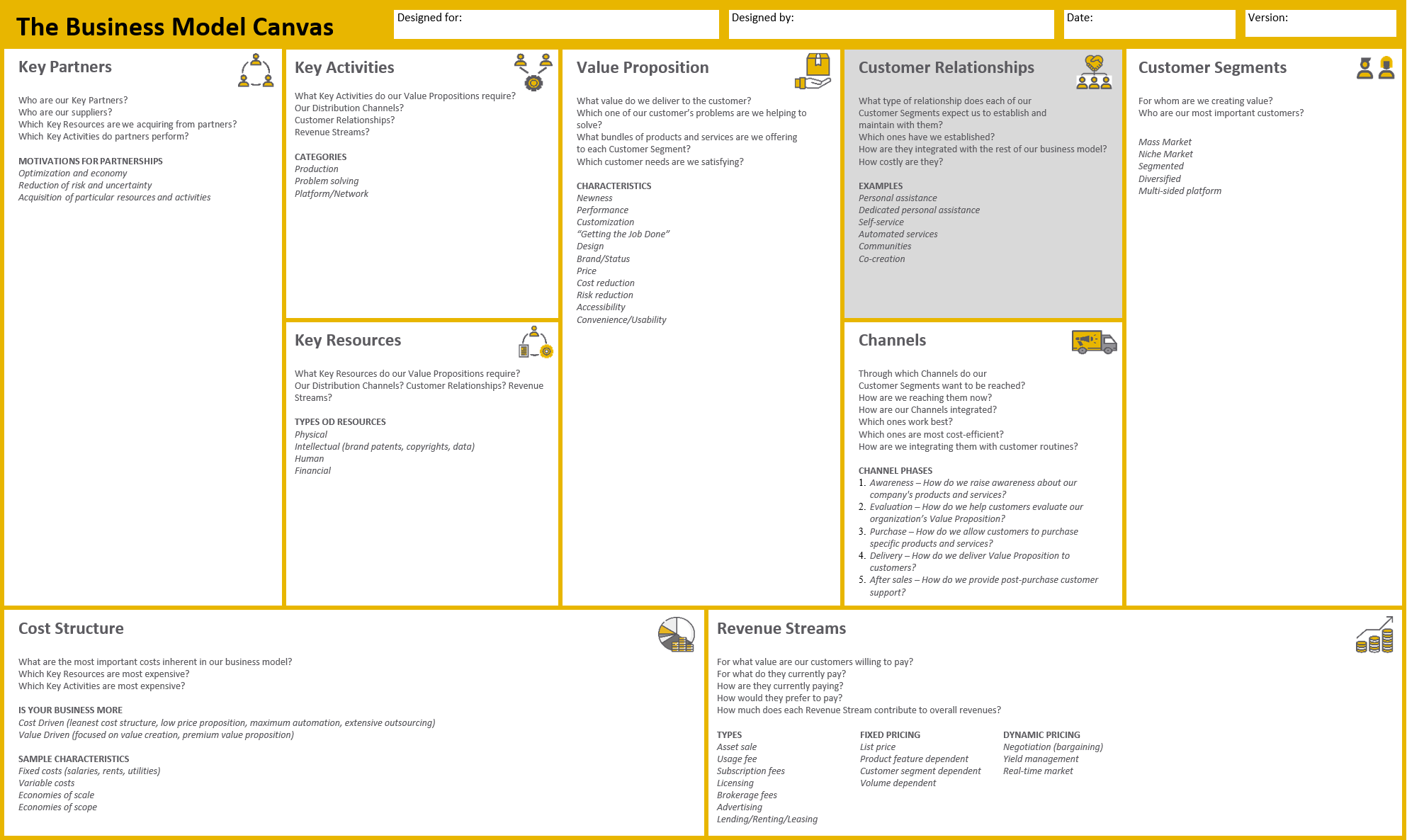Module 5
CUSTOMER RELATIONSHIPS
The purpose of this module is for learners to understand the value of customer relationships and to explore how customer relationship strategies may be structured and integrated into a company’s business model.



Customer relationships
Introduction
Customer Relationships describe the different types of relationships that an organization may have with different customer segments. For any organization to survive, sustaining and promoting long-term relationships with customers has become a core component of business models. To achieve a good relationship with customers, learners need to understand customer expectations in order to be able to meet and exceed these expectations and to build trust.
Purpose
The purpose of this module is for learners to understand the value of customer relationships and to explore how customer relationship strategies may be structured and integrated into a company’s business model.
Learning Outcomes
After the completion of this module the learner will be able to:
-
- Define what a Customer Relationship is;
- Explain the importance of Customer Relationships in a business model;
- Illustrate different Customer Relationship models;
- Describe and assess how different Customer Relationships are capable of impacting other components of an organization’s business model and vice-versa.
Keywords
-
- Customer Relationships
- Transactional Relationships
- Self-service
- Automated Self-service
- Personal Assistance
- Dedicated Personal Assistance
- Communities
- Co-creation
- Loyalty programs
- Switching costs
Theoretical background
Customer relationships are located on the top right-hand side of the business model canvas.

Goals
Customer Relationships may vary significantly, ranging from one-off transactional relationships with customers, to deeper long-term relationships built on trust, customer loyalty and brand value.
It is not a very obvious choice for an organization to forget to develop customer relationships, however, this strategy (of not considering a customer relationship) may work in a limited set of circumstances, as in the case of a 24/7 fully-automated store.
At the other end of the spectrum, many organizations strive to establish long-term relationships with their customers – not only through their products or services, but also by means of an identification with their environmental policies, life philosophies, or social status. Many brands are not only trying to sell products or services, but to instil positive emotions in their customers.
It is important to define what kind of relationship an organization would like to establish and maintain with each customer segment. These relationships may vary, ranging from automated relationships to personal relationships.
Goals such as the ones listed below should be taken into consideration when developing customer relationship strategies:
-
- Gaining new clients;
- Retaining clients;
- Increasing the client’s purchases / increasing profit.
Besides the previous goals, in the start-up phase of businesses, it is common for some organizations to focus on an aggressive customer acquisition strategy. This is done with the intention of acquiring increased market share. To acquire customers, organizations may offer discounts, equipment or even their services for free.
Once an organization is well-positioned within its respective market, the organization may decide to change its priorities in order to focus on customer retention and profitability.
Types
Organizations may have different Customer Relationships with different Customer Segments, and some relationships may co-exist within the same Customer Segment. Relationships may be either long-term, short-term or involve one-off interactions. Different types of customer relationships include:
-
- Transactional Relationships
- Self-service
- Automated Self-service
- Personal Assistance
- Dedicated Personal Assistance
- Communities
- Co-creation
- Loyalty programs
Transactional relationships
As the name indicates, a transactional relationship is based purely on the transaction itself. This may hardly be seen as a relationship. It could be an automated process, in which case it is likely that an organization will not emphasize personal customer relationships.
The use of a credit/debit card machine in stores is one such example. The person who uses the card might not even notice who the company running the machine is, or they may not even know that a percentage of the payment made is going to that company.
Self-Service
There is a very limited personal relationship with the customer when ‘self-service’ is involved, in this case, the company provides all the means so that the client can use the service by himself/herself.
With this type of relationship, the client may adapt the service to his or her needs, such as, for example, when in a self-service restaurant, or when using a self-service pump for gasoline.
Automated Self-Service
Automated self-service is an evolved version of self-service, where automation is used to assist the client. These services can recognize types of clients or even a specific client, providing a tailored offering to clients following a consideration of their features and previous orders, their transactions, or their services. At its best, these services can even mimic a personal relationship, providing suggestions. For example, some services, using online profiling, can offer suggestions of books, movies, and TV series.
Additional examples of automated self-service include:
-
- Airport self-service kiosks which allow customers to check themselves in.
- ATMs which allow customers to automatically withdraw cash.
- Check-in and check-out kiosks at hotels.
- Self-ordering technology in restaurants.
Personal Assistance
Customer relationships based on personal assistance largely involve human interactions between the client and the organization. Generally, the organization’s personnel communicate with a customer who asks for help during or after the sales process. The interaction may happen at the point of sale, by phone, email or by any other digital form, such as via a video call or a live chat.
Dedicated Personal Assistance
Dedicated personal assistance is a more hands-on and tailored approach towards personal assistance, with a dedicated employee allocated to a specific customer. This type of service aims for long-lasting relationships, which are the most profound kind of relationship that can be created between an organization and its customers. Dedicated personal assistance is generally used in private banking, or in small businesses for services such as tax accounts. It is a service which is difficult to replicate in segments with a huge number of clients.
Communities
Creating the means so that communities of clients or potential clients can emerge, this may bring multiple advantages to the companies. For example, communities might function as an independent trouble shooting platform for electronic equipment, and they may also be considered as a useful source of qualitative and quantitative information about clients and future clients. These communities may be nurtured purely by online events, although there may also be offline events such as gatherings or conferences. In this type of relationship, organizations can rely on customer expertise, and it also allows the brand to increase the involvement with the clients and among clients, creating a sense of community and belonging.
Co-creation
Co-creational relationships are very different from the traditional client-provider relationship. The aim of these relationships is to collaboratively create value with customers through bi-directional interactions. For example, many online sellers allow their customers to write reviews. Another example is sites that allow users to post new content, such as YouTube. Some companies also request help in the design of new products. This option not only empowers clients, allowing them to have a say and publicize their thoughts, but it also promotes an increase of trust in the service provider, because there are external independent reviewers, consultants or producers.
Loyalty programs
Loyalty programs aim to retain clients. These programs are generally based on the premise that it is much cheaper to retain a client than to acquire a new one. The loyalty plans which organisations develop may offer discounts or free products to customers who make repeat purchases or large purchases, such as, for example, free meals in some restaurants, or discount vouchers in other businesses. The loyalty program may adopt some form of status recognition, such as, for example, Gold or Platinum clients (as, for example, for some frequent flier programs), or any other sort of ranking among clients in order to promote the repeated use of that brand.
Variables to consider: Switching costs
These are the costs that a client has to pay in order to switch companies, such as, for example, to switch their communication service, their Bank, or the IT company that supports their webpage or other similar services.
These costs may be monetary, or they may incorporate loss of time, effort, or the loss of any information or material that cannot be ‘switched’ (or transferred) from one service to another.
A higher cost might mean that there is a lower probability of change. If a tech company provides a service that, by its nature, is not easy to be switched, then it might be an incentive to maintain that service provider. Switching costs may, however, also be one of the criteria for choosing a service in the first place, so it may influence a company’s client attraction. It is to be noted that creating artificial and unreasonable barriers will have an impact on the image that people have of an organization, and on the possibility of their returning as clients or of making a referral.
For example, companies that force clients into a process which is much more complicated than when they first started using the service, such as requiring clients who wish to switch to another service to go somewhere physically and to make phone calls, or to sign several papers, all of this is likely to have a negative impact on the image of that company.
Examples and Good practice
Living up to expectations
It is important to understand the expectations of your potential clients regarding the types of relationship they may develop, as this will impact how and what you communicate with them and how you deliver that which your promise.
Even if something goes wrong, such as selling a defective product, or not being able to provide the expected service, you have the opportunity to reaffirm your Customer Relationships by resolving the problem in the best way possible.
Ignoring a problem and not listening to your customers could result in the creation of a negative corporate image.
Falling short of customers’ expectations is one of the worst things that can happen to a company. It is therefore important for organizations to make an effort to provide the type of relationship that clients expect, within the parameters of their business.
Unbundling business
“Unbundling“, in simple terms, refers to the practice of separating different lines of business.
Some private banks decide to unbundle their business, understanding that they serve different customer segments, for example, some clients may search for wealth management, others may use various financial products, while others may use transaction platforms.
Among other objectives, the use of this technique, ‘unbundling’, may be an attempt to better understand what type of relationship makes more sense in each of these different segments, thus avoiding conflicting objectives and possible trade-offs.
For example, relationships established with very wealthy clients are generally long-term relationships based on dedicated Personal Assistance, while the relationship with other banks that use their platform can be achieved with Personal Assistance with efficient troubleshooting and high technical skills. Regarding the selling of financial products, this relationship is not as stable as the ones previously mentioned, and the relationship may range from a transactional one to personal assistance, but with different features.
Lego’s long tail business model
Lego, a toy company, decided to incorporate the long tail strategy in their business, that is, they not only sell their best selling toys, but they also allow clients to create and sell their own Lego creations. The long tail aims to “sell few of many”, instead of “many of few”. Selling a variety of different Lego products, even if in a small number, with a good business model to reduce the cost of selling many different products, allowed Lego to develop a new revenue stream.
The impact of Customer Relationships translates into the development of a Co-creation Relationship, which also acts to sustain the Lego Community – creating an even stronger bond with clients.
Xerox
When Xerox created the copy machine many years ago they encountered a hurdle – the machine was perceived as being too expensive, hindering the quantity of purchases, and, of course, the revenue streams. By way of altering their strategy, Xerox switched from the perspective of selling machines to leasing them to clients with a fee per month, with x copies per month included in the leasing cost and a price of x per copy for anything above the copy limit.
Xerox therefore evolved, from being only machine sellers, to partners that adopted the monthly cost (the leasing / subscription model) for the effective use of the machine. This strategic manoeuvre changed the customer relationship which was previously typical of a one time purchase into a long-term relationship.
Hewlett-Packard (HP)
More recently, HP followed the example provided by Xerox.
This example does not mention the bait and hook strategy where HP sells cheaper printers with the objective of selling multiple expensive ink cartridges (an online search will reveal more information on the bait and hook business model).
This example aims to highlight the Customer Relationship upgrade of the service “HP Instant Ink”, where the client, instead of buying cartridges in a store (either physical or virtual) when needed, simply needs to register for these services. Once the process is completed, new cartridges will be shipped to the home of the client, whenever needed, that is, when the ink levels are getting low, therefore making the possibility of the client running out of ink much lower. This service functions with a subscription, where the client pays for the number of copies they expect to print. There are extra costs if customers go beyond their agreed limit of copies printed.
The automated service (the process is automatic) that HP provide mimics a personal assistance experience. The client only has to choose the most appropriate package on offer for their use. The cartridges will be shipped exactly when needed, without anyone having to travel to a store to purchase an ink cartridge, or for an order, or a hassle to find a compatible cartridge. An automated suggestion for the consumer to change to a more suitable package will be made when the number of copies printed changes.
This service is also supported with a personal assistance relationship available through phone or email.
Being a product and service with all the benefits mentioned, the switching costs are also increased, not because it is difficult to cancel the service, but because it is not easy to identify another service with these same benefits. Losing these benefits is the real switching cost.
References and External Links
-
- https://www.youtube.com/watch?v=hoO5ZdKl2qE
- https://www.youtube.com/watch?v=Hp0Q8Z5Isz4&feature=emb_rel_pause
- https://www.cleverism.com/customer-relationship-block-in-business-model-canvas/
- https://asksuite.com/blog/top-10-self-service-technologies/
- Osterwalder, A., Pigneur, Y., In Clark, T., & Smith, A. (2010). Business model generation: A handbook for visionaries, game changers, and challengers.
Copyright @2021 – businessmodels.eu

